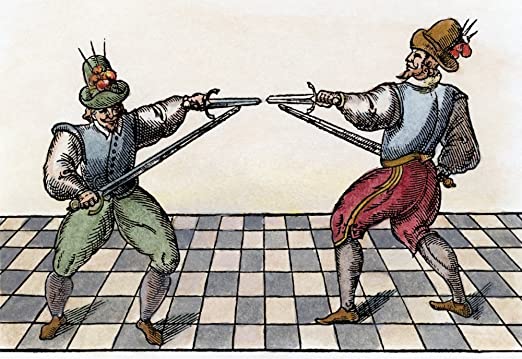Introduction
Vincentio Saviolo was originally from Padua, Italy, but his most accomplished works were done in England. Vincentio’s legacy was remembered for his mastery of 16th-century fencing. While Vincentio had great skill and could hold his own in a duel, he visioned more for this “activity.” He wanted another element to elevate this activity into the upper class and stray away from the common man. Vincentio decided that being born from generations of renaissance men; he would couple his skills with the etiquette and manners of the noblest man to bring to light this new version of dueling. While other masters lacked to see the value of his work, others sought out his expertise and original twist.
Vincentio was taken over with the idea that dueling needed to be an activity of great ethics, as well as honor. The majority of his book completely focuses on the strict rules and actions that must be taken to consider yourself a “dueler”. One main point was that one must act well in society. Using one’s sword out of the context of a duel was unacceptable, and any mishaps revoked one of the privileges. Duels must be agreed upon by both parties, and an issue must be at hand. Secondly, if you could not look the part, then this was not the activity for you. One had to be presentable when out in public and especially during a duel.
While Vincentio believed manners were of the utmost importance, looking the part was another part of his requirement. Besides dressing appropriately, your sword or rapier must be in the best possible condition. While this includes cleanliness, attention to detial also held its own importance. On the tang and ricasso parts of the sword, much time and detail went into designing the shape and engravings. Especially on the tang, often dueler would have the names of loved ones or bible verses sketched into the material.
Other masters of fencing during the time did not see eye to eye with Vincentio’s stress on following these strict and rigid rules. Specifically, George Silver, who was considered Vincentio’s nemesis, constantly ridiculed his ways. George was a teacher who focused more on actual fighting styles and tactics while leaving etiquette and manners aside.
Kelso, R. (1924). Saviolo and his Practise. Modern Language Notes, 39(1), 33-35. https://www.jstor.org/stable/2915085?seq=1#metadata_info_tab_contents Giddens, E. E. (1997). Calianax's challenge in The Maid's Tragedy. Notes and Queries, 44(4), 523-524. Chicago https://go.gale.com/ps/anonymousid=GALEA20413346&sid=googleScholar&v=2.1&it=r&linkaccess=abs&issn=00293970&p=AONE&sw=w Papineau, W. V. (2017, May 12). Book Review: " A Gentleman's Guide to Duelling " by Saviolo. https://www.academieduello.com/news-blog/book-review-gentlemans-guide-duelling-saviolo/ Amberger, C. (2014, June 6). History of the Sword. https://web.archive.org/web/20060108152646/http://www.swordhistory.com/home.html
